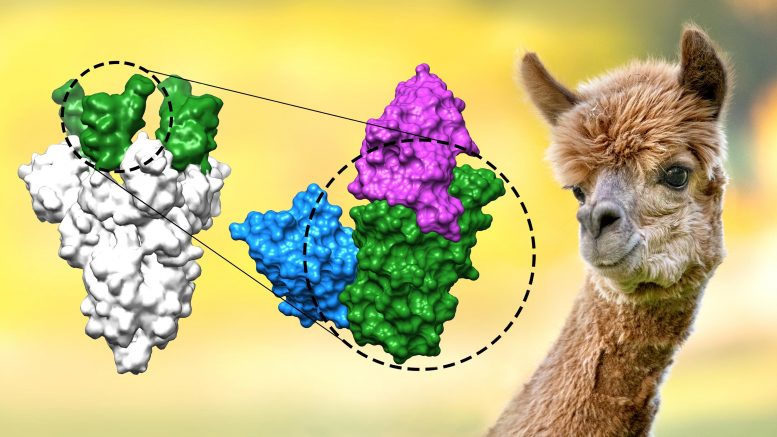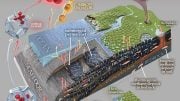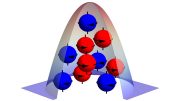
The figure shows how two of the newly developed nanobodies (blue and magenta) bind to the receptor-binding domain (green) of the coronavirus spike protein (grey), thus preventing infection with Sars-CoV-2 and its variants. The nanobodies originate from alpacas and are smaller and simpler than conventional antibodies. Credit: Max Planck Institute for Biophysical Chemistry
Göttingen researchers have developed mini-antibodies that efficiently block the coronavirus SARS-CoV-2 and its dangerous new variants. These so-called nanobodies bind and neutralize the virus up to 1000 times better than previously developed mini-antibodies. In addition, the scientists optimized their mini-antibodies for stability and resistance to extreme heat. This unique combination makes them promising agents to treat COVID-19. Since nanobodies can be produced at low costs in large quantities, they could meet the global demand for COVID-19 therapeutics. The new nanobodies are currently in preparation for clinical trials.
Antibodies help our immune system to fend off pathogens. For example, the molecules attach to viruses and neutralize them so that they can no longer infect cells. Antibodies can also be produced industrially and administered to acutely ill patients. They then act like drugs, relieving symptoms and shortening recovery from the disease. This is an established practice for treating hepatitis B and rabies. Antibodies are also used for treating COVID-19 patients. However, producing these molecules on an industrial scale is too complex and expensive to meet worldwide demand. Nanobodies could solve this problem.
Scientists at the Max Planck Institute (MPI) for Biophysical Chemistry in Göttingen (Germany) and the University Medical Center Göttingen (UMG) have now developed mini-antibodies (also known as VHH antibodies or nanobodies) that unite all the properties required for a potent drug against COVID-19. “For the first time, they combine extreme stability and outstanding efficacy against the virus and its Alpha, Beta, Gamma, and Delta mutants,” emphasizes Dirk Görlich, director at the MPI for Biophysical Chemistry.
At first glance, the new nanobodies hardly differ from anti-SARS-CoV-2 nanobodies developed by other labs. They are all directed against a crucial part of the coronavirus spikes, the receptor-binding domain that the virus deploys for invading host cells. The nanobodies block this binding domain and thereby prevent the virus from infecting cells.
“Our nanobodies can withstand temperatures of up to 95 °C (203 °F) without losing their function or forming aggregates,” explains Matthias Dobbelstein, professor and director of the UMG’s Institute of Molecular Oncology. “For one thing, this tells us that they might remain active in the body long enough to be effective. For another, heat-resistant nanobodies are easier to produce, process, and store.”
Single, double, and triple nanobodies
The simplest mini-antibodies developed by the Göttingen team already bind up to 1000 times more strongly to the spike protein than previously reported nanobodies. They also bind very well to the mutated receptor-binding domains of the Alpha, Beta, Gamma, and Delta strains. “Our single nanobodies are potentially suitable for inhalation and thus for direct virus neutralization in the respiratory tract,” Dobbelstein says. “In addition, because they are very small, they could readily penetrate tissues and prevent the virus from spreading further at the site of infection.”
A ‘nanobody triad’ further improves binding: The researchers bundled three identical nanobodies according to the symmetry of the spike protein, which is comprised of three identical building blocks with three binding domains. “With the nanobody triad, we literally join forces: In an ideal scenario, each of the three nanobodies attaches to one of the three binding domains,” reports Thomas Güttler, a scientist in Görlich’s team. “This creates a virtually irreversible bond. The triple will not let release the spike protein and neutralizes the virus even up to 30,000-fold better than the single nanobodies.” Another advantage: The larger size of the nanobody triad expectedly delays renal excretion. This keeps them in the body for longer and promises a longer-lasting therapeutic effect.
As a third design, the scientists produced tandems. These combine two nanobodies that target different parts of the receptor-binding domain and together can bind the spike protein. “Such tandems are extremely resistant to virus mutations and the resulting ‘immune escape’ because they bind the viral spike so strongly”, explains Metin Aksu, a researcher in Görlich’s team.
For all nanobody variants – monomeric, double as well as triple – the researchers found that very small amounts are sufficient to stop the pathogen. If used as a drug, this would allow for a low dosage and thus for fewer side effects and lower production costs.
Alpacas provide blueprints for mini-antibodies
“Our nanobodies originate from alpacas and are smaller and simpler than conventional antibodies,” Görlich says. To generate the nanobodies against SARS-CoV-2, the researchers immunized three alpacas – Britta, Nora, and Xenia from the herd at the MPI for Biophysical Chemistry – with parts of the coronavirus spike protein. The mares then produced antibodies, and the scientists drew a small blood sample from the animals. For the alpacas, the mission was then complete, as all further steps were carried out with the help of enzymes, bacteria, so-called bacteriophages, and yeast. “The overall burden on our animals is very low, comparable to vaccination and blood testing in humans,” Görlich explains.
Görlich’s team extracted around one billion blueprints for nanobodies from the alpacas’ blood. What then followed was a laboratory routine perfected over many years: The biochemists used bacteriophages to select the very best nanobodies from the initially vast pool of candidates. These were then tested for their efficacy against SARS-CoV-2 and further improved in successive rounds of optimization.
Not every antibody is ‘neutralizing’. Researchers of Dobbelstein’s group therefore determined if and how well the nanobodies prevent the viruses from replicating in cultured cells in the lab. “By testing a wide range of nanobody dilutions, we find out which quantity suffices to achieve this effect,” explains Antje Dickmanns from Dobbelstein’s team. Her colleague Kim Stegmann adds: “Some of the nanobodies were really impressive. Less than a millionth of a gram per liter of medium was enough to completely prevent infection. In the case of the nanobody triads, even another twenty-fold dilution was sufficient.“
Also effective against current coronavirus variants
Over the course of the coronavirus pandemic, new virus variants have emerged and rapidly became dominant. These variants are often more infectious than the strain that first appeared in Wuhan (China). Their mutated spike protein can also ‘escape’ neutralization by some originally effective antibodies of infected, recovered, or vaccinated persons. This makes it more difficult even for an already trained immune system to eliminate the virus. This problem also affects previously developed therapeutic antibodies and nanobodies.
This is where the new nanobodies show their full potential, as they are also effective against the major coronavirus variants of concern. The researchers had inoculated their alpacas with part of the spike protein of the first known SARS-CoV-2 virus, but remarkably, the animals’ immune system also produced antibodies that are active against the different virus variants. “Should our nanobodies prove ineffective against a future variant, we can reimmunize the alpacas. Since they have already been vaccinated against the virus, they would very quickly produce antibodies against the new variant,” Güttler asserts confidently.
Therapeutic application in view
The Göttingen team is currently preparing the nanobodies for therapeutic use. Dobbelstein emphasizes: “We want to test the nanobodies as soon as possible for safe use as a drug so that they can be of benefit to those seriously ill with COVID-19 and those who have not been vaccinated or cannot build up an effective immunity.” The team is supported by experts in technology transfer: Dieter Link (Max Planck Innovation), Johannes Bange (Lead Discovery Center, Dortmund, Germany), and Holm Keller (kENUP Foundation).
The receptor-binding domain of SARS-CoV-2 is known to be a good candidate for a protein vaccine but so far difficult to manufacture economically on a large scale and in a form, which activates the immune system against the virus. Bacteria programmed accordingly produce incorrectly folded material. The Göttingen researchers discovered a solution for this problem: They identified special nanobodies that enforce correct folding in bacterial cells, without obstructing the crucial neutralizing part of the receptor-binding domain. This might allow for vaccines that can be produced inexpensively, can be quickly adapted to new virus variants, and can be distributed with simple logistics even in countries with little infrastructure. “The fact that nanobodies can help with protein folding was previously not known and is extremely interesting for research and pharmaceutical applications,” Görlich says.
Reference: “Neutralization of SARS-CoV-2 by highly potent, hyperthermostable, and mutation-tolerant nanobodies” by Thomas Güttler, Metin Aksu, Antje Dickmanns, Kim M. Stegmann, Kathrin Gregor, Renate Rees, Waltraud Taxer, Oleh Rymarenko, Jürgen Schünemann, Christian Dienemann, Philip Gunkel, Bianka Mussil, Jens Krull, Ulrike Teichmann, Uwe Groß, Volker C. Cordes, Matthias Dobbelstein and Dirk Görlich, 24 July 2021, The EMBO Journal.
DOI: 10.15252/embj.2021107985









These nanobodies, if they work, would be great for clogging up the spike proteins. But the real problem is the virus inside its protein shell and why two of the most dangerous, MERS and Covid-19, are so infectious. My independent research has found multiple one-in-a-million nucleotide sequence matches between all the coronaviruses and the human genome. Those sequences are the same as some of the DHU loops of human tRNA. Using those loops and their anticodon matches, viruses may be able to fool the nucleus membrane in cells to allow the virus to enter and associate with the human DNA, creating more opportunities for further infection. Our immune system may be compromised and may no longer be able to stop the virus and other diseases from attacking organs throughout the body. Vaccines that attack the virus protein shells while ignoring their contents are doomed to failure from the Darwin effect, but recognizing these DHU loops suggests a possible approach to successful coronavirus vaccines. For MERS, eliminating the nucleotide sequence CAGTGGTAG from the virus may make it less infectious and stimulate the body to create antibodies to attack the entire virus. And eliminating the nucleotide sequence TAGTGGTGAG from Covid-19 may do the same thing. Only the infection process is considered in my work, not the innate virulence of the virus. For more info, check out this YouTube: https://www.youtube.com/watch?v=pd4OD4GpsJI
Always below the DOI, and never above it. Have a sale on snake oil today?
But will Big Pharma allow it. To protect the astronomical profits, they deliberately obstruct any treatment other than their current products.
The REAL problem with Nanobody treatments is how long they take to get approval. Covid may very well be long gone before any of these treatments become commercially available. A treatment that is available too late is not going to be very helpful. Personally, if I were in an ICU facing possible death, I’d rather be the guinea pig for this nasal spray treatment than be intubated (97% died in NYC that were intubated). But it’s NOT an option for anyone whatsoever.
Both mRNA makers (Pfizer and Moderna) updated their vaccines in a single weekend to address Delta, but the FDA treats these changes as starting from scratch rather than a simple update that should be speed through approval and thus the push for a 3rd shot using existing vaccines rather than the preferred booster that directly addresses Delta instead.
Until the FDA gets with the 21st Century and moves at a speed fast enough to actually stop a Pandemic, we will continue to be at risk. Not producing the vaccines fast enough to get it around the world in a timely fashion is the other huge problem and that is due more to economic GREED than anything else. Human lives really do have a price tag and it’s right around $40 a person (times 8 billion). I’m betting these companies prefer limited distribution as new variants mean more future profits…. Who cares if the rest of us have to live with travel restrictions and mask mandates for the rest of our lives so long as BIG Pharma makes BIG money?
The new manufacturing facilities for these can be operational in 6-8 months now instead of years, so you may want to include that info next time. The people who can run them unfortunately still take a very long time to get through school and I’m personally not willing to relent on that one. It’s not exactly Bausch & Lomb.